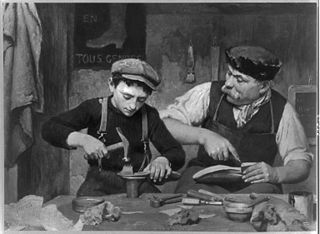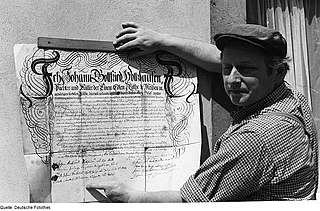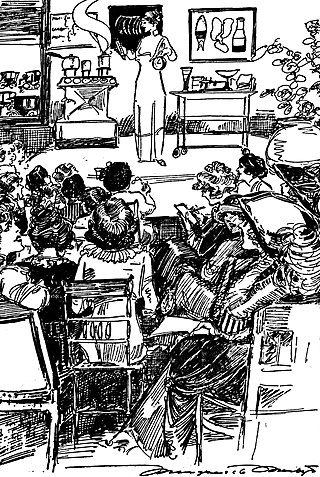
Apprenticeship is a system for training a new generation of practitioners of a trade or profession with on-the-job training and often some accompanying study. Apprenticeships can also enable practitioners to gain a license to practice in a regulated occupation. Most of their training is done while working for an employer who helps the apprentices learn their trade or profession, in exchange for their continued labor for an agreed period after they have achieved measurable competencies.

Carpentry is a skilled trade and a craft in which the primary work performed is the cutting, shaping and installation of building materials during the construction of buildings, ships, timber bridges, concrete formwork, etc. Carpenters traditionally worked with natural wood and did rougher work such as framing, but today many other materials are also used and sometimes the finer trades of cabinetmaking and furniture building are considered carpentry. In the United States, 98.5% of carpenters are male, and it was the fourth most male-dominated occupation in the country in 1999. In 2006 in the United States, there were about 1.5 million carpentry positions. Carpenters are usually the first tradesmen on a job and the last to leave. Carpenters normally framed post-and-beam buildings until the end of the 19th century; now this old-fashioned carpentry is called timber framing. Carpenters learn this trade by being employed through an apprenticeship training—normally 4 years—and qualify by successfully completing that country's competence test in places such as the United Kingdom, the United States, Canada, Switzerland, Australia and South Africa. It is also common that the skill can be learned by gaining work experience other than a formal training program, which may be the case in many places.
A journeyman is a worker, skilled in a given building trade or craft, who has successfully completed an official apprenticeship qualification. Journeymen are considered competent and authorized to work in that field as a fully qualified employee. They earn their license by education, supervised experience and examination. Although journeymen have completed a trade certificate and are allowed to work as employees, they may not yet work as self-employed master craftsmen.

A blue-collar worker is a working class person who performs manual labor. Blue-collar work may involve skilled or unskilled labor. The type of work may involve manufacturing, warehousing, mining, excavation, electricity generation and power plant operations, electrical construction and maintenance, custodial work, farming, commercial fishing, logging, landscaping, pest control, food processing, oil field work, waste collection and disposal, recycling, construction, maintenance, shipping, driving, trucking, and many other types of physical work. Blue-collar work often involves something being physically built or maintained.

A craft or trade is a pastime or an occupation that requires particular skills and knowledge of skilled work. In a historical sense, particularly the Middle Ages and earlier, the term is usually applied to people occupied in small scale production of goods, or their maintenance, for example by tinkers. The traditional term craftsman is nowadays often replaced by artisan and by craftsperson (craftspeople).

An artisan is a skilled craft worker who makes or creates material objects partly or entirely by hand. These objects may be functional or strictly decorative, for example furniture, decorative art, sculpture, clothing, food items, household items and tools and mechanisms such as the handmade clockwork movement of a watchmaker. Artisans practice a craft and may through experience and aptitude reach the expressive levels of an artist.

Historically, a master craftsman or master tradesman was a member of a guild. The title survives as the highest professional qualification in craft industries.

A vocational school, trade school, or technical school is a type of educational institution, which, depending on the country, may refer to either secondary or post-secondary education designed to provide vocational education or technical skills required to complete the tasks of a particular and specific job. In the case of secondary education, these schools differ from academic high schools which usually prepare students who aim to pursue tertiary education, rather than enter directly into the workforce. With regard to post-secondary education, vocational schools are traditionally distinguished from four-year colleges by their focus on job-specific training to students who are typically bound for one of the skilled trades, rather than providing academic training for students pursuing careers in a professional discipline. While many schools have largely adhered to this convention, the purely vocational focus of other trade schools began to shift in the 1990s "toward a broader preparation that develops the academic" as well as technical skills of their students.
A millwright is a craftsperson or skilled tradesperson who installs, dismantles, maintains, repairs, reassembles, and moves machinery in factories, power plants, and construction sites.
A skilled worker is any worker who has special skill, training, knowledge which they can then apply to their work. A skilled worker may have learned their skills on the work experience, on-the-job training, an apprenticeship program or formal education. These skills often lead to better outcomes economically. The definition of a skilled worker has seen change throughout the 20th century, largely due to the industrial impact of the Great Depression and World War II. Further changes in globalisation have seen this definition shift further in Western countries, with many jobs moving from manufacturing based sectors to more advanced technical and service based roles. Examples of formal educated skilled labor include engineers, scientists, doctors and teachers, while examples of informal educated workers include crane operators, CDL truck drivers, machinists, drafters, plumbers, craftsmen, cooks and accountants.

A glazier is a tradesman responsible for cutting, installing, and removing glass. They also refer to blueprints to figure out the size, shape, and location of the glass in the building. They may have to consider the type and size of scaffolding they need to stand on to fit and install the glass. Glaziers may work with glass in various surfaces and settings, such as cutting and installing windows, doors, shower doors, skylights, storefronts, display cases, mirrors, facades, interior walls, ceilings, and tabletops.
Industrial training institutes (ITI) and industrial training centers (ITC) are post-secondary schools in India constituted under the Directorate General of Training (DGT), Ministry of Skill Development and Entrepreneurship, Union Government, to provide training in various trades.
Skill is a measure of the amount of worker's expertise, specialization, wages, and supervisory capacity. Skilled workers are generally more trained, higher paid, and have more responsibilities than unskilled workers.

Journeyman papers, or a journeyman's licence, is a certification granted to tradesmen upon completion of an apprenticeship. The certificate verifies that the worker is skilled in their trade. A tradesmen who has received this certification is referred to as a journeyman.

Vocational education in the United States varies from state to state. Vocational schools are post-secondary schools that teach the skills necessary to help students acquire jobs in specific industries. The majority of postsecondary career education is provided by proprietary (privately-owned) career institutions. About 30 percent of all credentials in teaching are provided by two-year community colleges, which also offer courses transferable to four-year universities. Other programs are offered through military teaching or government-operated adult education centers.

The working class comprises those engaged in manual-labour occupations or industrial work, who are remunerated via waged or salaried contracts. Working-class occupations include blue-collar jobs, and most pink-collar jobs. Members of the working class rely exclusively upon earnings from wage labour; thus, according to more inclusive definitions, the category can include almost all of the working population of industrialized economies, as well as those employed in the urban areas of non-industrialized economies or in the rural workforce.
Apprenticeships have a long tradition in the United Kingdom, dating back to around the 12th century. They flourished in the 14th century and were expanded during the industrial revolution. In modern times, apprenticeships were formalised in 1964 by act of parliament and they continue to be in widespread use to this day.
Apprenticeship programs in the United States are regulated by the Smith–Hughes Act (1917), The National Industrial Recovery Act (1933), and National Apprenticeship Act, also known as the "Fitzgerald Act."











